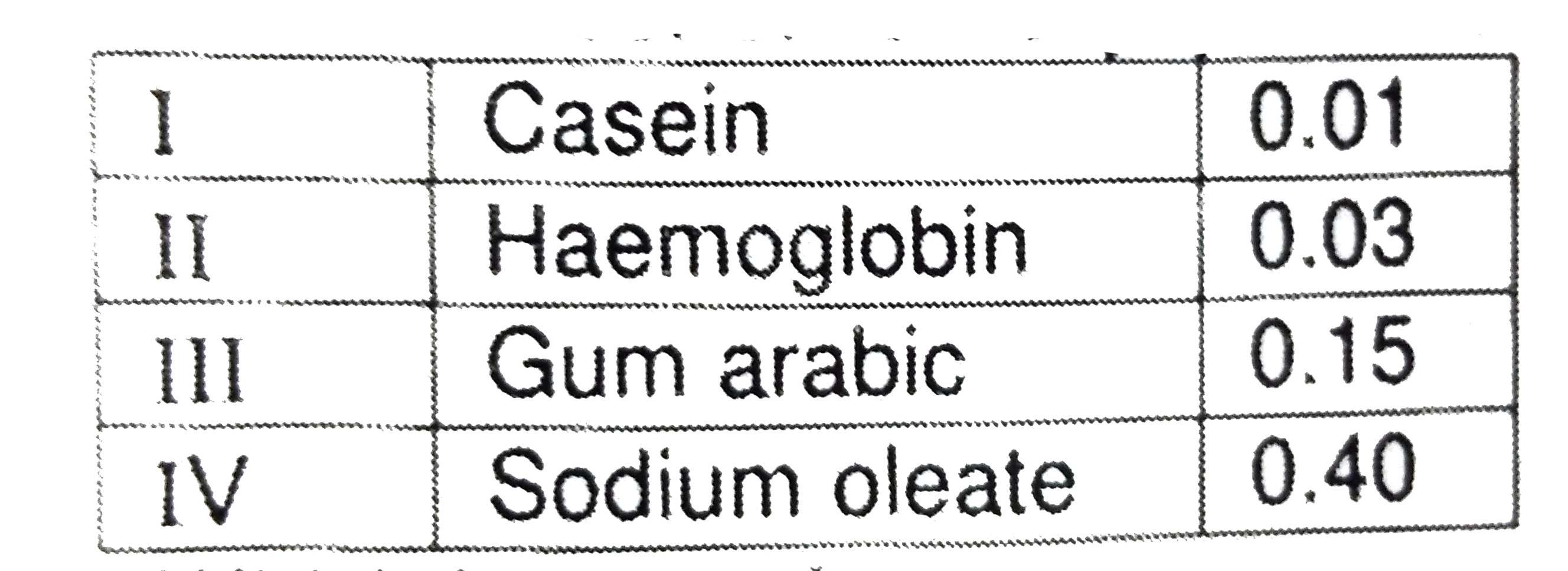An arsenious sulphide sol carries a negative charge the maximum precipitating power fo this sol is possessed by
K2SO4
CaCl2
Na2PO4
AlCl3
The correct Answer is:4
To solve the question regarding the maximum precipitating power of an arsenious sulfide sol that carries a negative charge, we can follow these steps:
1. Understanding the Charge of the Sol:
- The question states that arsenious sulfide sol carries a negative charge. This means that the particles in the sol are negatively charged.
2. Coagulation of Colloids:
- Colloidal particles can be coagulated or precipitated by the addition of ions that carry an opposite charge. Since the sol is negatively charged, it can be coagulated by positive ions.
3. Identifying the Precipitating Ions:
- We need to look at the options provided (K2SO4, CaCl2, Na2Pa4, and AlCl3) and identify which of these contains positive ions that can precipitate the negatively charged arsenious sulfide sol.
4. Determining the Valency of Cations:
- The effectiveness of a cation in precipitating a negatively charged sol is related to its valency. The higher the valency of the cation, the greater its power to cause precipitation.
- Let's analyze the cations in the given compounds:
- K2SO4: Contains K⁺ (valency +1)
- CaCl2: Contains Ca²⁺ (valency +2)
- Na2Pa4: Contains Na⁺ (valency +1)
- AlCl3: Contains Al³⁺ (valency +3)
5. Comparing the Valencies:
- Among the cations listed, Al³⁺ has the highest valency of +3. Therefore, it will have the maximum precipitating power.
6. Conclusion:
- Based on the analysis, the cation with the highest valency, which is Al³⁺ from AlCl3, will possess the maximum precipitating power for the negatively charged arsenious sulfide sol.
Final Answer:
- The maximum precipitating power for the arsenious sulfide sol is possessed by AlCl3.
---
- The question states that arsenious sulfide sol carries a negative charge. This means that the particles in the sol are negatively charged.
- Colloidal particles can be coagulated or precipitated by the addition of ions that carry an opposite charge. Since the sol is negatively charged, it can be coagulated by positive ions.
- We need to look at the options provided (K2SO4, CaCl2, Na2Pa4, and AlCl3) and identify which of these contains positive ions that can precipitate the negatively charged arsenious sulfide sol.
- The effectiveness of a cation in precipitating a negatively charged sol is related to its valency. The higher the valency of the cation, the greater its power to cause precipitation.
- Let's analyze the cations in the given compounds:
- K2SO4: Contains K⁺ (valency +1)
- CaCl2: Contains Ca²⁺ (valency +2)
- Na2Pa4: Contains Na⁺ (valency +1)
- AlCl3: Contains Al³⁺ (valency +3)
- Among the cations listed, Al³⁺ has the highest valency of +3. Therefore, it will have the maximum precipitating power.
- Based on the analysis, the cation with the highest valency, which is Al³⁺ from AlCl3, will possess the maximum precipitating power for the negatively charged arsenious sulfide sol.
- The maximum precipitating power for the arsenious sulfide sol is possessed by AlCl3.
Topper's Solved these Questions
- SURFACE CHEMISTRYBOOK - RESONANCE ENGLISHCHAPTER - SURFACE CHEMISTRYEXERCISE - Solved Examples
9 Videos
- SURFACE CHEMISTRYBOOK - RESONANCE ENGLISHCHAPTER - SURFACE CHEMISTRYEXERCISE - Solved Problems
11 Videos
- STRUCTURAL IDENTIFICATIONBOOK - RESONANCE ENGLISHCHAPTER - STRUCTURAL IDENTIFICATIONEXERCISE - Advanced level Problems (Part-III)
12 Videos
- TEST PAPERSBOOK - RESONANCE ENGLISHCHAPTER - TEST PAPERSEXERCISE - FST-3
30 Videos
Similar Questions
An AgI sol carries a negative charge. The maximum precipitating power is possessed by which of these electrolytes?
View SolutionCadmium sulphide sol has negative charge. The maximum power of coagulation is of:
View SolutionA subatomic particle that carries a negative charge
View SolutionMetal sol is negatively charged. True/False
View SolutionAs2S3 sol has a negative charge. Capacity to precipitate it is highest in:
View Solutionwhich of the following sol is negatively charged ?
View SolutionGold number of some lyophilic sols are :

Which has maximum protective power :
View SolutionArsenic (III) sulphide forms a sol with a negative charge.
Which of the following ionic substances should be most effective in coagulating the sol?
View SolutionThe maximum power to precipitate arsenious suiphide is of
View SolutionWhich of the following sols is negatively charged?
View Solution
